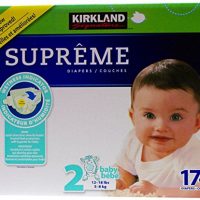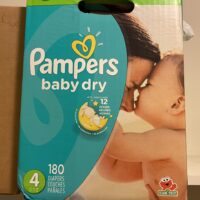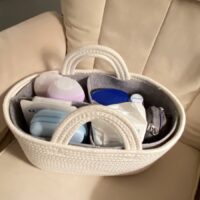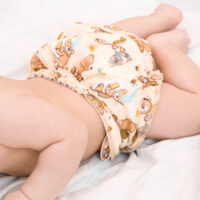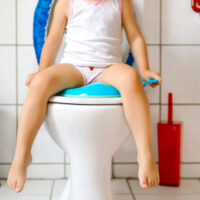The right diaper fit is so important.
Your baby will go through 2,200 diapers in the first year alone.
After the first birthday, it’s variable how many more years of diapering is ahead. Experts say that children should be showing signs of potty-training readiness by age three, but some can take another year from that to get the whole thing down.
That’s a lot of diapers, so you’ll want each and every diaper to be comfortable and contain any messes!
How a Diaper Should Fit
How a Disposable Diaper Should Fit
Diapers should fit snugly on your baby’s waist and legs, but it shouldn’t be too tight. It should be snug enough to keep the diaper up, but not tight enough to give your little one a “muffin top,” or the look where their little baby chub rolls out of the top.
There is a fantastic hack on some diapers for checking if you have the diaper fastened tightly enough. Grab a diaper and look at the front of it. Your diaper is purely decorated in cute characters, but you will also notice markings that look out of place. If you see dark parallel markings, those are indicative of where you should tape the diaper wings!
Instead of lines, some of the best diapers build their tab indicators into the design of the diaper. At the top, you may notice little printed tabs with buttons or something similar. If you’re anything like me, you didn’t think any of those lines or designs until after several months of diaper changing!
The front should fit below the belly button and it definitely should never cover up the umbilical stump of a newborn. In fact, many newborn diapers have a small notch at the top of the diaper to keep the umbilical stump unobstructed.
Around the back, you’ll want the diaper to sit and create a straight line across the back. The back rides up higher than the front with tab diapers. Of course, all cracks, so to speak, should be well hidden. If the diaper is low enough to slip or sag and expose any bit of baby butt, you most likely have an ill-fitting diaper.
How a Tape-Free Disposable Diaper Should Fit
All of the above discusses the traditional diaper with tape. Once your toddler begins to toddle about, you may want to consider a disposable tape-free diaper.
Tapeless diapers are a newer innovation. Sure, we’ve had Pull-Ups for a while, but they aren’t quite the same. Pull-Ups are intended for potty-training kids, meaning it doesn’t have to be super absorbent. Translated, that means Pull-Ups can cause some big-time leaks.
These new stretchy diapers are made to absorb like a diaper but fit like a Pull-Up. Plus, I’ll be honest: I think they are way easier. Bonus: my son can’t unfasten the tabs anymore and run around naked.
Diapers with tape are easier to put on a baby who is laying down. I can’t get my kid to lay still that long. Meanwhile, tabless diapers pull up like underwear, so diaper changes can occur while the toddler is standing up.
The basic general rules of a good fit still apply here, with minor changes. For one, you can’t check how far in the tabs can reach on the waistband. Instead, you’ll have to gauge if the diaper does or doesn’t slide easily up over the baby’s bottom.
You still don’t want any baby muffin tops. There should not be red marks left on the belly or thighs when the diaper is removed. The diaper should still sit below the belly button.
If you’d like a tapeless diaper, your choices are Pampers Cruisers 360 Fit or Huggies Little Movers Slip-On diapers. Hopefully, other brands will jump on this tape-free trend soon!
How a Cloth Diaper Should Fit
Maybe your family has made the decision to cloth diaper. Cloth diapers are extremely similar to disposable diapers in fit but have minor differences.
There are so many different versions and types of diapers, but for the most part, they should all fit the same. The biggest difference you’ll find is size. For example, some cloth diapers are only intended for one size. Others have rows of snaps that allow the diaper to grow with your baby.
Most surprisingly, with a cloth diaper, a red mark from the diaper is not always a bad sign. Because cloth diapers are thicker and more durable than their disposable counterparts, they are closer to clothing. After wearing socks all day, you often have imprints on your ankles, but that doesn’t mean your socks are too tight!
A cloth diaper does not have leg cuffs like a disposable diaper. So, when putting on the cloth diaper, make sure that the leg hole lines up with the crease of the baby’s leg. Any lower or higher and you might be facing leakage. After the diaper is fastened, check for any gaping in the leg hole. Also, if any absorbent material has snuck its way out, go ahead and tuck that back in.
After the baby is all snapped in, you may find you have extra fabric sticking out. Since a lot of cloth diapers accommodate many sizes, that’s normal. If you have any excess fabric, tuck it away. The additional fabric on the front can be folded under the tummy panel of buttons.
Like with a disposable diaper, you shouldn’t be able to find more than two finger widths in the diaper’s waistband. If it’s too big, you can adjust the size by buttoning it tighter.
Cloth diapers should rest just below the belly button as well. Disposable diapers can be folded down to expose the belly button, but cloth diapers can’t do that. Try tucking excess fabric in the front. If no amount of adjusting brings the diaper below the belly button, you may need to try a different brand or size.
Is Your Baby’s Diaper the Right Fit?
If you’ve got some great diapers that just aren’t doing what they should when it comes to containing messes, here are some easy ways to tell whether your baby has a properly fitting diaper or the wrong diaper size.
Signs a Diaper is Too Small
Your baby is growing and growing; there doesn’t seem to be a break in sight! As she sprouts upward and outward, you’re growing concerned that her diaper is too small for her. Your instinct is probably correct, but to be sure, look out for the signs of a too-tight diaper.
First, notice how the tabs fit. If you can’t get the tabs to meet in the center of the waistband anymore, your baby needs the next size up. Likewise, do a quick finger test. Can you fit two fingers under the waistband? If not, the diaper is too small.
Second, there are visual signs. When you take off the diaper, your baby has red marks and lines on his tummy or thighs. You wouldn’t wear a pair of pants that left an irritation on your waist after all!
Remember though, this only applies to disposable diapers. Cloth diapers can leave red marks, but be sure to judge. If the red marks look too irritated, then the cloth diaper is probably too small.
Your baby also needs to size up if she’s getting a little cheeky. And I don’t mean mischievous. If her little bottom is hanging out the sides of the diaper, it’s time for a new size.
Likewise, look where the diaper lays. While it should not cover the belly button, it shouldn’t rest too far below it. If your baby is rocking a low-rise diaper, move on up.
If your baby’s diaper is a tapeless one, take note of how hard it is to pull the diaper up. You may find it is increasingly difficult to slide the diaper up over your baby’s little bottom. If you are pulling up the diaper, meet resistance, and the sides of the diaper rip? Yes, you’re right – that diaper is too small.
Next, observe how your baby moves in the diaper. Diapers need to adapt and move with a baby’s body. If your baby is clearly uncomfortable in the diaper, take note. If he tugs at the diaper often or even attempts to remove it, then you should try a size up.
Last, but certainly not least, consider moving up a size if your baby is having frequent blowouts. Every baby experiences diaper blowouts every now and then, but if you’re cleaning up an explosion every other diaper change, that diaper is too small.
Signs a Diaper is Too Big
A too-big diaper isn’t a common fit issue. Usually, you start at the bottom of the diaper hierarchy (newborn sizes) and gradually work your way up.
Still, even if it’s uncommon, you can still find yourself in a too-big situation. For example, maybe you decide to switch brands. Every brand has its own sizing and fit. A size 3 in a Pampers might not translate to a size 3 in Huggies.
Similarly, you may think your baby needs a larger size, only to discover you took the leap too soon.
With a diaper that is too big, you’ll experience leaks and blowouts like a small diaper. While small diapers run out of room quicker, larger diapers have too much room at the legholes to hold in the mess.
A bigger diaper is typically only an issue if the leg holes aren’t snug enough. If you encounter a diaper that’s too large at the waist, you can fold the diaper’s top and tape it down.
To check the leg hole spaciousness, do the finger test. If you can fit more than two fingers in the waistband or the leghole, the diaper is too big for your baby. Plus, that baby’s next pee will leak right out.
As mentioned in the section describing the right fit, you don’t want a low-rise diaper. If your baby’s diaper is sliding down to become a hip-hugger, try a smaller diaper.
Figuring Out Diaper Sizes
Since the size is so important to how a diaper fits, you surely want to get the Goldilocks “just-right” size for your little one, but what exactly is the right size?
With our clothes, adults go and try items on and judge how they fit then. For diapers, there isn’t a fitting room option. You have to grab a package of diapers and cross your fingers that they fit.
Every diaper brand includes its own sizing chart, based on the baby’s weight, but these can be confusing. Diaper size charts should be used as a jumping-off point since weight doesn’t accurately describe anyone’s body shape,
For example, my 2.5-year-old is a hearty 34 pounds. He’s an eater! If I input his weight into his diaper brand’s size calculator, it suggests he is in-between a size 4 and 5.
Here’s where it gets confusing. A size 4 is labeled for 22-37 pounds, while a size 5 is for “27 pounds and over.” If you need to pick between a size 4 and 5 for a 34-pound toddler, how do you pick the correct size?
The punchline here is that my son doesn’t wear a size 4 or 5. He wears size 6 diapers. They give him more stretch on his little round belly!
The point of my diaper math is to let you know that diaper sizes are confusing for everyone. You can’t follow size charts exactly. It’s better to try a couple of sizes to see how it fits your unique baby.
Frequently Asked Questions about Diaper Fit
How do I pick the right diaper?
There is no “right” diaper. The best diaper is the one your baby is comfortable wearing. I honestly feel we all fall into diaper brand loyalty accidentally.
At the hospital when my son was born, we received several diapers of a particular brand. Out of habit, I kept with that brand. Now, it’s the only brand I’ll buy. I once switched brands out of curiosity and my son got a rash!
I know fellow parents that don’t care at all what the hospital provided and instead went with the most affordable diaper. This is a fine metric to go with! If your baby can wear the cheapest diaper on the shelf and have no skin issues, then, by all means, buy those cheap diapers!
As a first-time parent, you may have to try a few different diaper brands and decide what fit and style you like best. Stick with small packs of diapers for your trial and error process.
How can I weigh a baby at home to check their diaper sizing?
As you rock your baby around, probably in the middle of the night, you do notice they are getting heavier every day, which makes you wonder if you should be looking into a different diaper size.
Here is one tip from a parent who’s been there. Well-visits to the doctor can be far apart and your baby can easily fit a major growth spurt between these appointments. For sizing purposes, you may want to know how much weight your baby gained.
There’s no way of getting a baby to sit still on a bathroom scale and you probably don’t have a baby scale like the pediatrician. No worries, you can still do this.
Jump onto the scale yourself and note how much you weigh. This isn’t a guilt trip about your extra snacks this week, I swear! Next, step on the scale while holding your baby.
Now take your combined weight and subtract your weight! Ta-da! You now know how much your little angel weighs and can consult diaper size charts.
Should a diaper fit over the belly button?
No, it should not. This is usually a question from parents of newborns. Newborns still have the umbilical stump and it may seem reasonable to cover it up with a diaper.
According to the American Pregnancy Association, the stump should be exposed to open air as often as possible. The group even recommends letting a child wear only a shirt and diaper if temperature permits. This lets the stump properly air out and prevents irritation.
Most newborn diapers feature a notch cut out of the top of the diaper to avoid covering the stump. If your chosen disposable diaper overlaps the belly button, just fold it down. If the cloth diaper you use covers up the belly button, it may not be the right diaper for your baby.
Once your newborn is no longer a newborn, the diaper should still not conceal the belly button. Instead, it should fit comfortably below it.
Do you need to size up a diaper for nighttime?
The short answer is maybe. The long answer is that you absolutely can, but you don’t need to.
If your baby is leaking through diapers through the night on a regular basis, you may want to consider an alternative diaper. There are a few different choices though.
Some parents do choose to purchase a pack of their normal diaper choice in a size up for nighttime diapers. A bigger diaper has more room and more absorbency to stop messes. Sticking with the same diaper brand is beneficial because your baby’s skin is already accustomed to it and there won’t be any surprise skin rashes.
Depending on the diaper size and your baby’s weight, the size up might be too big though. If the gap between the leg and leg holes are too wide, you’ll wake up to an unpleasant leak situation.
What about overnight diapers?
There are also special diapers made just for nighttime use. Overnight diapers are more absorbent than daytime diapers, meaning your baby will stay dry through 10 hours of sleep. If you’re looking to get more sleep, remember a dry baby doesn’t wake up as often as a baby with a leaky diaper.
All of the major labels, like Huggies, Pampers, and store brands, have their own line of overnight diapers. If you want, you can stick with your preferred brand of choice!
In the end, if the leaks are minimal but you still want to give your baby extra dryness protection, try a booster pad. A booster pad is a small absorbent liner added to the interior of a diaper. This means your baby gets her regular diaper with a little extra boost in absorbency.
How can you prevent diaper blowouts?
I know that diapers blowouts are a parental rite of passage, but I could do without them. There are a few things you can try to do to prevent a nasty blowout.
The most obvious tip is to change your baby’s diaper often. They won’t have a chance to overflow their pants if the diaper is replaced enough.
Next, you’ll need to determine if the diaper is the right size for your baby. Read our above sections for how to know if a diaper is too big or too small.
If your baby can really fill a disposable diaper, you may want to try cloth diapering. The material of cloth diapers is thicker and able to withstand larger loads.
Lastly, if you’re absolutely desperate, you can buy a blowout blocker. This is a diaper extension that is attach offers more absorbency up the baby’s back. It velcros around the waist, like a diaper, but polyester attachment reaches up the back.
Final Thoughts
For how simple diapers seem, they end up being rather complicated. Finding just the right diaper, in terms of size and fit, can be a journey. Still, it’s important to know how a diaper should fit, including the signs of an ill-fitting diaper, because your baby can’t speak and tell you they’re uncomfortable! No matter if you go disposable or cloth, you can ensure your baby has a properly fitting diaper.
For disposable diapers, check for red marks and leaks. Cloth diapers should have the leg holes line up with the crease of the leg. For both diapers, you shouldn’t be able to fit more than two finger widths under the waistband. Likewise, keep the diaper below the belly button.
These tips and tricks are guidelines, but as the parent, you can trust your instinct too. You know your baby better than anyone. You can follow all the guidelines and still, something might not be right. If you are noticing your baby looking uncomfortable in a certain diaper, then switch it up!



